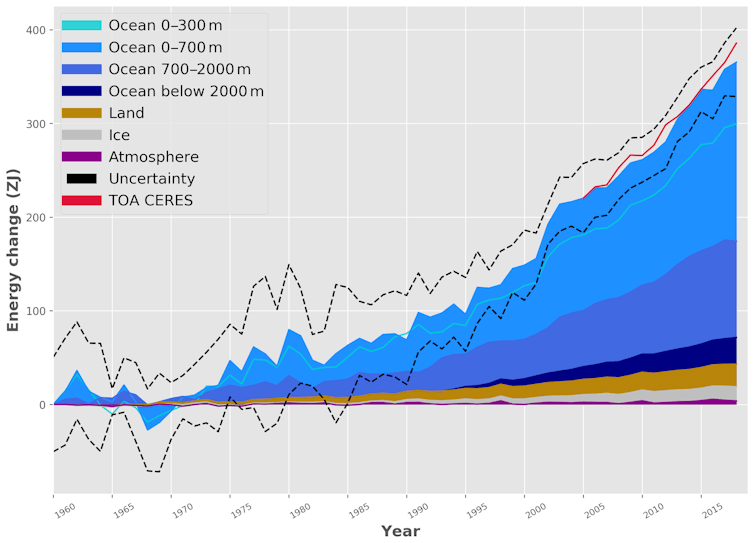
By Maurice Huguenin, Matthew England and Ryan Holmes
Over the last 50 years, the oceans have been working in overdrive to slow global warming, absorbing about 40% of our carbon dioxide emissions, and over 90% of the excess heat trapped in the atmosphere.
But as our research published today in Nature Communications has found, some oceans work harder than others.
We used a computational global ocean circulation model to examine exactly how ocean warming has played out over the last 50 years. And we found the Southern Ocean has dominated the global absorption of heat. In fact, Southern Ocean heat uptake accounts for almost all the planet’s ocean warming, thereby controlling the rate of climate change.
This Southern Ocean warming and its associated impacts are effectively irreversible on human time scales, because it takes millennia for heat trapped deep in the ocean to be released back into the atmosphere.
This means changes happening now will be felt for generations to come – and those changes are only set to get worse, unless we can stop carbon dioxide emissions and achieve net zero.

Shutterstock
It’s important yet difficult to measure ocean heating
Ocean warming buffers the worst impacts of climate change, but it’s not without cost. Sea levels are rising because heat causes water to expand and ice to melt. Marine ecosystems are experiencing unprecedented heat stress, and the frequency and intensity of extreme weather events is changing.
Yet, we still don’t know enough about exactly when, where and how ocean warming occurs. This is because of three factors.
First, temperature changes at the ocean surface and in the atmosphere just above track each other closely. This makes it difficult to know exactly where excess heat is entering the ocean.
Second, we don’t have measurements tracking temperatures over all of the ocean. In particular, we have very sparse observations in the deep ocean, in remote locations around Antarctica and under sea ice.
Last, the observations we do have don’t go back very far in time. Reliable data from deeper than 700 metres depth is virtually non-existent prior to the 1990s, apart from observations along specific research cruise tracks.

Our modelling approach
To work out the intricacies of how ocean warming has played out, we first ran an ocean model with atmospheric conditions perpetually stuck in the 1960s, prior to any significant human-caused climate change.
Then, we separately allowed each ocean basin to move forward in time and experience climate change, while all other basins were held back to experience the climate of the 1960s.
We also separated out the effects of atmospheric warming from surface wind-driven changes to see how much each factor contributes to the observed ocean warming.
By taking this modelling approach, we could isolate that the Southern Ocean is the most important absorber of this heat, despite only covering about 15% of the total ocean’s surface area.
In fact, the Southern Ocean alone could account for virtually all global ocean heat uptake, with the Pacific and Atlantic basins losing any heat gained back into the atmosphere.
One significant ecological impact of strong Southern Ocean warming is on Antarctic krill. When ocean warming occurs beyond temperatures they can tolerate, the krill’s habitat contracts and they move even further south to cooler waters.
As krill is a key component of the food web, this will also change the distribution and population of larger predators, such as commercially viable tooth and ice fish. It will also further increase stress for penguins and whales already under threat today.
So why is the Southern Ocean absorbing so much heat?
This largely comes down to the geographic set-up of the region, with strong westerly winds surrounding Antarctica exerting their influence over an ocean that’s uninterrupted by land masses.
This means the Southern Ocean winds blow over a vast distance, continuously bringing masses of cold water to the surface. The cold water is pushed northward, readily absorbing vast quantities of heat from the warmer atmosphere, before the excess heat is pumped into the ocean’s interior around 45-55°S (a latitude band just south of Tasmania, New Zealand, and the southern regions of South America).
This warming uptake is facilitated by both the warmer atmosphere caused by our greenhouse gas emissions, as well as wind-driven circulation which is important for getting heat into the ocean interior.
And when we combine the warming and wind effects only over the Southern Ocean, with the remaining oceans held back to the climate of the 1960s, we can explain almost all of the global ocean heat uptake.
But that’s not to say the other ocean basins aren’t warming. They are, it’s just that the heat they gain locally from the atmosphere cannot account for this warming. Instead, the massive heat uptake in the Southern Ocean is what has driven changes in total ocean heat content worldwide over the past half century.
We have much to learn
While this discovery sheds new light on the Southern Ocean as a key driver of global ocean warming, we still have a lot to learn, particularly about ocean warming beyond the 50 years we highlight in our study. All future projections, including even the most optimistic scenarios, predict an even warmer ocean in future.
And if the Southern Ocean continues to account for the vast majority of ocean heat uptake until 2100, we might see its heat content increase by as much as seven times more than what we have already seen up to today.
This will have enormous impacts around the globe: including further disturbances to the Southern Ocean food web, rapid melting of Antarctic ice shelves, and changes in the ocean conveyor belt.
To capture all of these changes, it’s vital we continue and expand our observations taken in the Southern Ocean.
One of the most important new data streams will be new ocean floats that can measure deeper ocean temperatures, as well as small temperature sensors on elephant seals, which give us essential data of oceanic conditions in winter under Antarctic sea ice.
Even more important is the recognition that the less carbon dioxide we emit, the less ocean change we will lock in. This will ultimately limit the disruption of livelihoods for the billions of people living near the coast worldwide.
![]()
Maurice Huguenin is a doctoral candidate, UNSW Sydney, Matthew England is Scientia Professor and Deputy Director of the ARC Australian Centre for Excellence in Antarctic Science (ACEAS), UNSW Sydney, Ryan Holmes is Research fellow at the University of Sydney.




























Timothy Patrick Welch says
So…
If we already know global warming is a fact, why do we need to continue to find new ways to monitor its affect. Potentially causing more damage to the environment? My guess, those that sent the alarm need more money!
Jimbo99 says
Exactly, more money hasn’t solved it. Population keeps moving towards using more energy fossil fuel & battery and all that has become is more inflation & energy crisis. So as long as the masses consume more, the environment will suffer for it. Guess they need to keep score in a game that was over a long time ago. Evidently for Flagler Beach the solution is higher taxes and spreading the cost of the beach replenishment to the entire county and dumping more sand over the ledge on the East side of A1A to experience the next storms of erosion ?